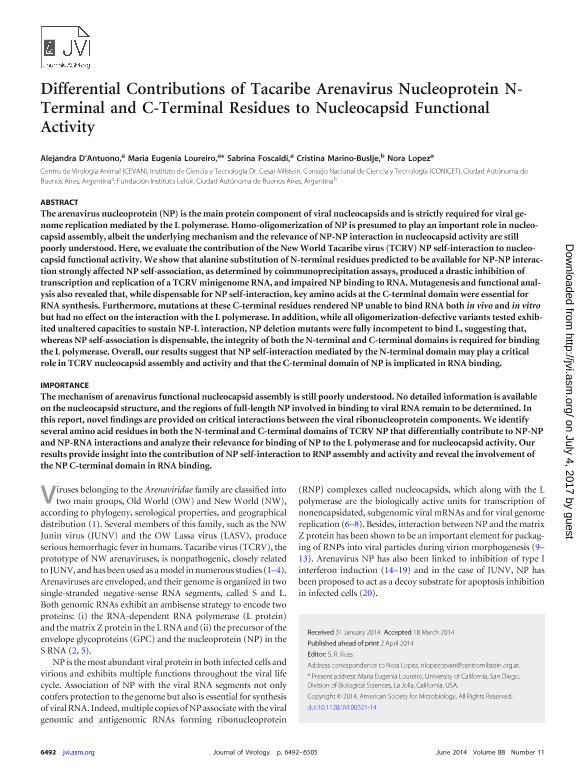Mostrar el registro sencillo del ítem
dc.contributor.author
D'antuono, Alejandra Lorena

dc.contributor.author
Loureiro, Maria Eugenia

dc.contributor.author
Foscaldi, Sabrina Andrea

dc.contributor.author
Marino, Cristina Ester

dc.contributor.author
Lopez, Nora Mabel

dc.date.available
2017-07-04T20:27:18Z
dc.date.issued
2014-06
dc.identifier.citation
D'antuono, Alejandra Lorena; Loureiro, Maria Eugenia; Foscaldi, Sabrina Andrea; Marino, Cristina Ester; Lopez, Nora Mabel; Differential contribution of Tacaribe arenavirus Nucleoprotein N-terminal and C-terminal residues to nucleocapsid functional activity; American Society For Microbiology; Journal Of Virology; 88; 11; 6-2014; 6492-6505
dc.identifier.issn
0022-538X
dc.identifier.uri
http://hdl.handle.net/11336/19535
dc.description.abstract
The arenavirus nucleoprotein (NP) is the main protein component of viral nucleocapsids and is strictly required for viral genome replication mediated by the L polymerase. Homo-oligomerization of NP is presumed to play an important role in nucleocapsid assembly, albeit the underlying mechanism and the relevance of NP-NP interaction in nucleocapsid activity are still poorly understood. Here, we evaluate the contribution of the New World Tacaribe virus (TCRV) NP self-interaction to nucleocapsid functional activity. We show that alanine substitution of N-terminal residues predicted to be available for NP-NP interaction strongly affected NP self-association, as determined by coimmunoprecipitation assays, produced a drastic inhibition of transcription and replication of a TCRV minigenome RNA, and impaired NP binding to RNA. Mutagenesis and functional analysis also revealed that, while dispensable for NP self-interaction, key amino acids at the C-terminal domain were essential for RNA synthesis. Furthermore, mutations at these C-terminal residues rendered NP unable to bind RNA both in vivo and in vitro but had no effect on the interaction with the L polymerase. In addition, while all oligomerization-defective variants tested exhibited unaltered capacities to sustain NP-L interaction, NP deletion mutants were fully incompetent to bind L, suggesting that, whereas NP self-association is dispensable, the integrity of both the N-terminal and C-terminal domains is required for binding the L polymerase. Overall, our results suggest that NP self-interaction mediated by the N-terminal domain may play a critical role in TCRV nucleocapsid assembly and activity and that the C-terminal domain of NP is implicated in RNA binding. IMPORTANCE: The mechanism of arenavirus functional nucleocapsid assembly is still poorly understood. No detailed information is available on the nucleocapsid structure, and the regions of full-length NP involved in binding to viral RNA remain to be determined. In this report, novel findings are provided on critical interactions between the viral ribonucleoprotein components. We identify several amino acid residues in both the N-terminal and C-terminal domains of TCRV NP that differentially contribute to NP-NP and NP-RNA interactions and analyze their relevance for binding of NP to the L polymerase and for nucleocapsid activity. Our results provide insight into the contribution of NP self-interaction to RNP assembly and activity and reveal the involvement of the NP C-terminal domain in RNA binding.
dc.format
application/pdf
dc.language.iso
eng
dc.publisher
American Society For Microbiology

dc.rights
info:eu-repo/semantics/openAccess
dc.rights.uri
https://creativecommons.org/licenses/by-nc-sa/2.5/ar/
dc.subject
Tcrv
dc.subject
Nucleoprotein
dc.subject.classification
Virología

dc.subject.classification
Ciencias Biológicas

dc.subject.classification
CIENCIAS NATURALES Y EXACTAS

dc.title
Differential contribution of Tacaribe arenavirus Nucleoprotein N-terminal and C-terminal residues to nucleocapsid functional activity
dc.type
info:eu-repo/semantics/article
dc.type
info:ar-repo/semantics/artículo
dc.type
info:eu-repo/semantics/publishedVersion
dc.date.updated
2016-02-04T16:12:09Z
dc.identifier.eissn
1098-5514
dc.journal.volume
88
dc.journal.number
11
dc.journal.pagination
6492-6505
dc.journal.pais
Estados Unidos

dc.journal.ciudad
Washington
dc.description.fil
Fil: D'antuono, Alejandra Lorena. Consejo Nacional de Investigaciones Científicas y Técnicas. Oficina de Coordinación Administrativa Parque Centenario. Instituto de Ciencias y Tecnología "dr. Cesar Milstein"; Argentina
dc.description.fil
Fil: Loureiro, Maria Eugenia. Consejo Nacional de Investigaciones Científicas y Técnicas. Oficina de Coordinación Administrativa Parque Centenario. Instituto de Ciencias y Tecnología "dr. Cesar Milstein"; Argentina
dc.description.fil
Fil: Foscaldi, Sabrina Andrea. Consejo Nacional de Investigaciones Científicas y Técnicas. Oficina de Coordinación Administrativa Parque Centenario. Instituto de Ciencias y Tecnología "dr. Cesar Milstein"; Argentina
dc.description.fil
Fil: Marino, Cristina Ester. Consejo Nacional de Investigaciones Científicas y Técnicas. Oficina de Coordinación Administrativa Parque Centenario. Instituto de Investigaciones Bioquímicas de Buenos Aires. Fundación Instituto Leloir. Instituto de Investigaciones Bioquímicas de Buenos Aires; Argentina
dc.description.fil
Fil: Lopez, Nora Mabel. Consejo Nacional de Investigaciones Científicas y Técnicas. Oficina de Coordinación Administrativa Parque Centenario. Instituto de Ciencias y Tecnología "dr. Cesar Milstein"; Argentina
dc.journal.title
Journal Of Virology

dc.relation.alternativeid
info:eu-repo/semantics/altIdentifier/url/http://jvi.asm.org/content/88/11/6492.long
dc.relation.alternativeid
info:eu-repo/semantics/altIdentifier/doi/http://dx.doi.org/10.1128/JVI.00321-14
Archivos asociados
